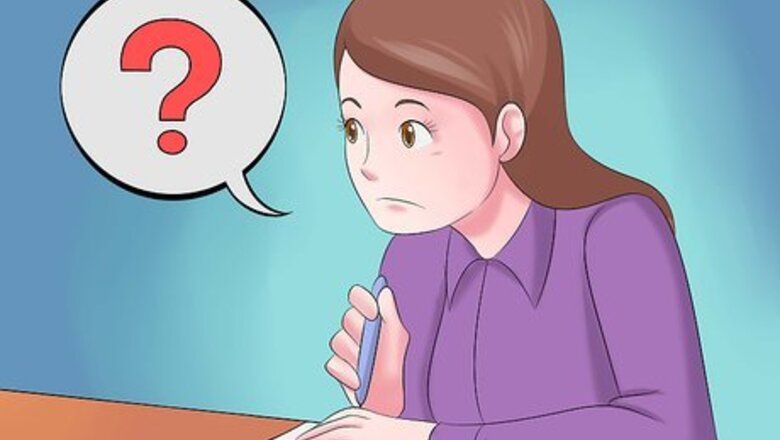
views
Putting a Panel Together

Select a topic. Ideally, the topic of discussion should be important to enough people that you can involve people with significantly different interests or backgrounds. However, avoid the trap of making a topic so general or vague that the discussion becomes unfocused. If you are having difficulty balancing these goals, remember the topic does not need to be divisive. Some panels are created to offer advice or information, and these do not always have competing points of view on display.

Recruit varied participants. A panel of three to five people usually creates the most interesting discussion. Look for well-informed people from a variety of backgrounds. For instance, a member of the public involved in the issue, someone with experience working with the issue in a business or nonprofit, and an academic who has studied the issue. Create a panel with variation in age, gender, and ethnicity as well, as a person's personal background can have a significant effect on his perspective. Inviting at least four people may be safest, in case someone cancels at the last minute. Invite these people several weeks in advance at a minimum, to allow them adequate time to prepare, and to give yourself time to find alternatives if one of them turns the offer down.

Invite a moderator. Select an additional person not participating in the panel discussion, to serve as a moderator. Ideally, she should already have experience moderating panels. Select someone who understands the topic well enough to follow the discussion, and who is skilled in social situations. The moderator's main purpose is to keep the panelists focused on the audience, keep the discussion running smoothly, and help out the panelists when they stall.
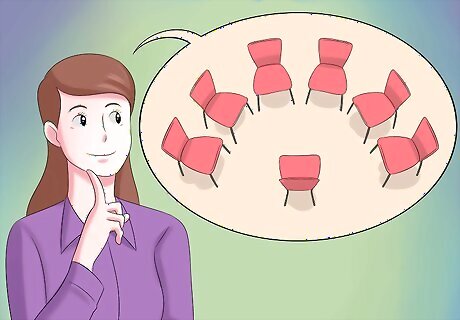
Plan the physical setup. Individual chairs will make the participants appear closer to the audience than a solid table, encouraging audience participation. Arranging the seats in a slight circle, still mostly facing the audience, may help the panelists discuss the topic with each other. Include small tables or stands for holding notes, and provide a glass of water for each participant. Unless the room seats thirty people or fewer, provide at least one microphone for each two participants, and a personal microphone for the moderator. Consider seating the moderator in the middle of the panelists to help him address and guide each panelist efficiently. Keeping the moderator at a podium off to one side may make his job more difficult.
Planning the Panel Discussion

Figure out the goals of the panel. Make sure all of the participants know why the panel has been assembled well in advance, so they have time to prepare. Your panel may be trying to present practical solutions to a problem, host a complex, abstract discussion, or provide information on a topic. Let the panelists know whether the panel is a basic introduction to the topic, or whether they can expect the audience to be fairly well-informed and looking for more advanced advice or nuanced perspectives.

Decide how long the panel should last. For most panels, especially those taking place at a conference or other larger event, 45–60 minutes is the recommended length of time. If the panel is a standalone event, or if it covers a particularly important and popular topic, a 90 minute panel may be appropriate. If possible, ask participants to stick around for some time after the session, so audience members can talk in person.

Consider starting with individual lectures (optional). The main focus of the panel should always be a discussion. However, if one of the panel's main goals is providing information, this may be a useful way to precede the discussion.Have each panelist provide an explanation of the topic, or her argument concerning the topic, lasting no more than ten minutes per person. This method may require more preparation time for the panelists as a group, as each panelist should build off the previous argument, rather than cover the same ground.

Try to avoid visual presentations. Unless absolutely necessary for the topic, avoid PowerPoint presentations and slides. They tend to slow down the discussion, keep audience involvement low, and often bore the listeners. Use a small number of slides, and only when information or diagrams need to be presented that cannot easily be explained in words alone. If a panelist asks for permission to create a presentation, suggest he bring in "show and tell" items instead to pass around the audience during discussion.

Write questions for the panelists. Try to come up with several open-ended questions, which the panelists can take in a direction best suited to the course of the discussion and their expertise. A few more specific questions directed at an individual panelist are also acceptable, but try to divide these among the panelists fairly evenly. Anticipate questions audience members might ask, and include these as well. Arrange these in rough order of most to least importance, as you should provide more questions than you expect to get through. Try to keep each question tied into the last however, avoiding a sudden change of topic. Have the moderator or another person not on the panel look over your questions and suggest edits or additional questions. If you are having trouble coming up with questions, ask each panelist individually what he would like to ask the other panelists. Include the best of these questions in your list.

Plan out the rest of the panel. Determine how much time you will set aside for questions; typically, this constitutes half the panel's length or more. Use the last 20–30 minutes for audience questions and discussion, or 15 minutes if time is short or you have a more lecture-focused panel format.

Introduce the panelists to each other in advance. Have the panelists meet in person or attend a conference call together, a week or more in advance of the panel. Describe the format of the panel to them, and give them a chance to talk briefly. They may briefly determine who should field questions on which topic, but don't give them the specific questions in advance. The discussion should be original, not rehearsed.
Moderating a Panel Discussion

Convince people to sit in the front row. The closer the panel is to the audience member, the more energetic and involved the atmosphere will feel. Consider offering small "freebies" if people move to the front rows, such as buttons or candy.

Briefly introduce the panel and each participant. Use only one or two sentences to introduce the panel topic, since most audience members present are likely familiar with the basic idea. Introduce each participant briefly, mentioning only a couple relevant facts about her experience or involvement related to the topic. Avoid going into a complete biography; the introduction of all participants should take no more than ten minutes total.

Involve the audience early. Get the audience invested in the panel by asking for their involvement right away. A simple, quick way to do this is to begin by asking for a rough poll of their opinion related to the topic, using a show of hands or applause. Alternatively, poll the audience on their level of knowledge of the topic. The results should help you keep the panel focused on topics most relevant to the audience.

Ask the panelists the prepared questions. Start going through the questions in the prearranged order, but don't hesitate to adjust this order if the discussion moved in a different, interesting direction. Divide questions among the participants, aiming them at the person most knowledgeable on the topic. Give other panelists a short amount of time to respond, then move on to the next question. Don't have every panelist weigh in on every question. Let the panelists respond naturally, when they have something to say, or prompt someone who is knowledgeable on the topic if the discussion is faltering.

Follow through with your own questions as necessary. You may deviate from the prepared questions whenever you think it will benefit from the discussion. In particular, press a panelist with a followup question if you think his answer is unsatisfying. Try rephrasing the original question, or ideally, come up with a more nuanced question that ties the last response to another discussion point or a previous statement.
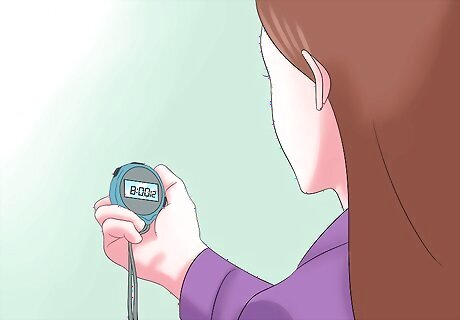
Get a timekeeper. You may look at an actual clock offstage or on the opposite wall, if one is clearly visible. Otherwise, have someone stand at the back of the room with visible signs saying "10 min," "5 min," and "1 min", holding these up as appropriate when you are nearing the end of a section.
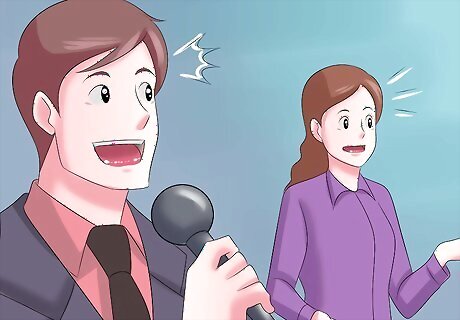
Keep the panelists on task. When a panelist is going on too long, or going off topic, politely return the discussion to the correct point. When she pauses for breath, jump in with a phrase similar to one of the following. You may choose to let panelists know beforehand what phrases you'll be using to bring them back on track. "You have an interesting point, but let's hear more about ___" "Let's see what (other panelist) has to say on that topic, especially how it relates to __."

Collect questions from the audience. Let the audience know how you plan to recruit question, for instance by calling on raised hands or inviting them to wait in line at a microphone. Listen to each question in turn, repeat it clearly so everyone in the room can hear, then refer it to a panelist who appears interested. Have a couple backup questions ready to ask yourself, or have an assistant in the audience ask, in case no one is brave enough to ask first question. If an audience member is taking up too much time, politely interrupt to say "So your question is ___, is that right?" or "I'm sorry, we need to keep things moving. What is your question?" Let people know when you only have enough time for two or three more questions.

Thank everyone involved. Thank the panelists, the hosts and organizers of the event, and the audience members. Let the audience members know the location and topic of an upcoming event, if you are at a symposium or conference.

















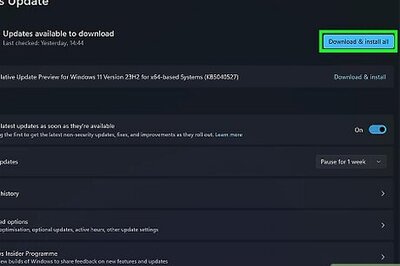
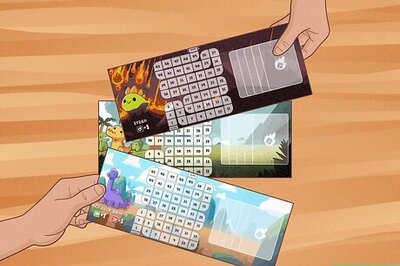
Comments
0 comment